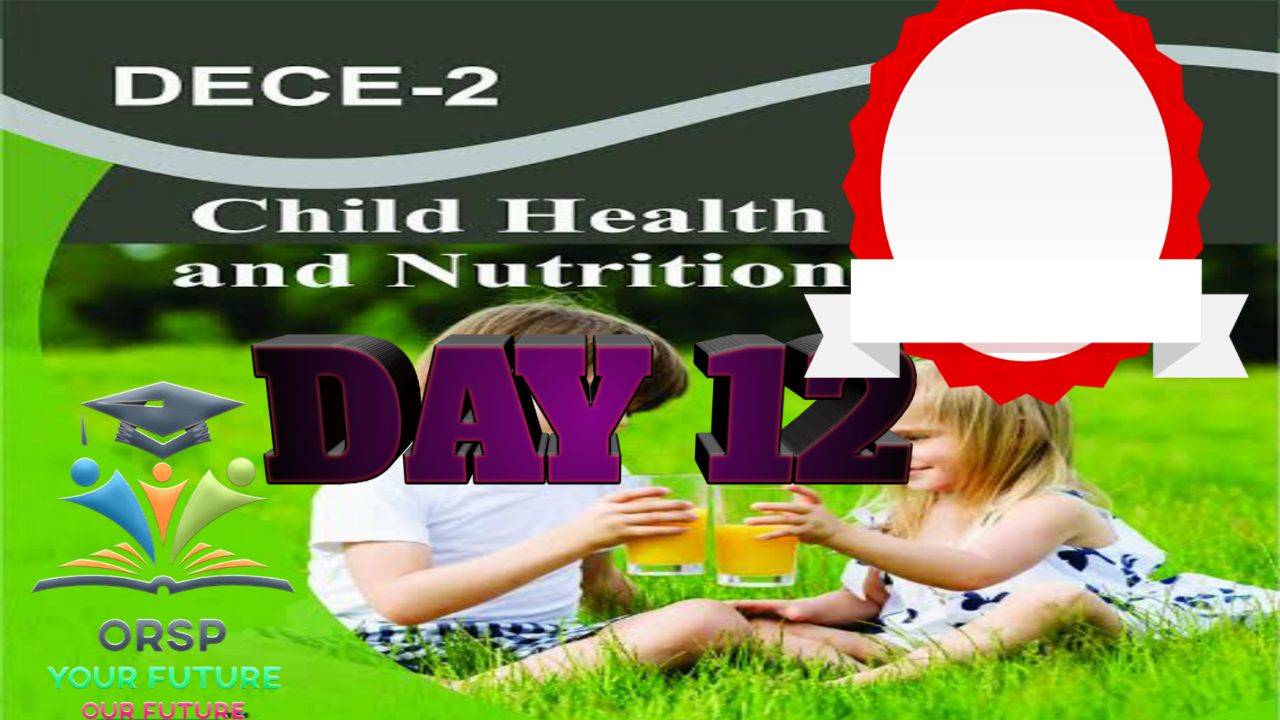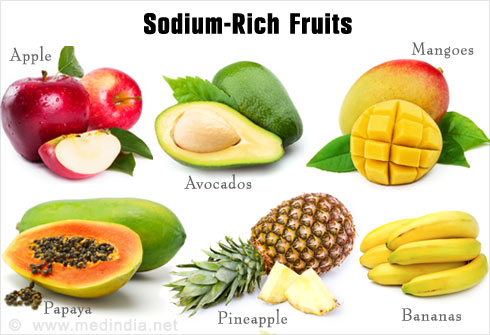DECE2-Solution(ENGLISH)-IGNOU-DAY 12-ORSP



DECE2-Solution(ENGLISH)-IGNOU-DAY 12-ORSP
Welcome To
Odisha Regional Study Point
We Allows the best competitive exam preparation for SSC,BANKING, RAILWAY &Other State Exam(CT,BE.d)…etc
In ଓଡ଼ିଆ Language…
Why opt ORSP?
✅Daily Free Live class
✅Daily Free practice Quiz
✅FREE Live Tests Quiz
✅Performance Analysis
✅All Govt Exams are Covered
DECE2-Solution(ENGLISH)-IGNOU-DAY 12-ORSP
Contents
Chapters
Chapter-1 Introduction to Nutrition and Health
Unit 1 The Concept of Nutrition
Unit 2 The Concept of Health
Unit 3 Indicators of Health
Chapter-2 Basic Concepts in Nutrition
Unit 4 The Macronutrients-I: Carbohydrates And Water
Unit-5 The Macronutrients-II: Proteins and Fats
Unit-6 The Micronutrients-1 : Vitamins
Unit-7 The Micronutrients-II: Minerals
Unit-8 Planning Balanced Diets
Chapter-3 Nutrition and Health Care during Pregnancy and Lactation
Unit-9 Meal Planning for Pregnant and Lactating Women
Unit-10 Health Care during Pregnancy
Unit-11 Health Care during Intranatal and Postnatal Periods
Chapter-4 Nutrition and Health Care during Infancy and Early Childhood
Unit-12 Nutrition during Infancy
Unit-13 Nutrition during Early Childhood
Unit-14 Health Care of the Child
Chapter-5 Nutrition Related Disorders in Early Childhood
Unit-15 Major Deficiency Diseases – 1: PEM and Xerophthalmia
Unit-16 Major Deficiency Diseases – II: Anaemia and lodine Deficiency Disorders
Unit-17Other Nutritional Disorders
Chapter-6 Nutrition and Health Programmes
Unit-18 Major Nutrition Programme
Unit-19 Major Health Programme
Unit-20 Assessment of Nutritional Status
Chapter-7 Common Childhood Illnesses, Their Prevention and Management -1
Unit-21 Caring for the Sick Child I
Unit-22 Some Disorders of the Alimentary System
Unit-23 Some Disorders of the Respiratory System
Unit-24 Some Infections of the Mouth and Throat
Unit-25 Some Problems of the Eyes
Chapter-8 Commom Childhood illness,Their Prevention And Management
Unit-26 Common Diseases of the Skin
Unit-27 Common Problems of the Bars
Unit-28 Fevers
Unit-29 Lumps and Swellings
Unit-30 First Aid
DECE2-Solution(ENGLISH)-IGNOU-DAY 12-ORSP
Chapter-2
Basic Concepts in Nutrition
Q1. Describe the processes of digestion, absorption and utilization of food.(10 MARK)
Q9. List the food sources of each of these minerals.
Ans. Calcium and Phosphorus
Food sources:
- Which foods provide good amounts of calcium? Milk and milk
products like curd, channa cottage cheese) are excellent sources of calcium. - Foods like fish especially dried fish and other sea foods (e.g. crab) provide substantial quantities of calcium.
- Among the plant sources, ragi (a millet grown in South India) is particularly rich in
calcium. - Pulses like bengal gram, black gram, green gram, moth beans, rajmah,
soyabean contribute substantial amounts of calcium. - Green leafy vegetables (like
amaranth leaves, colocasia leaves, fenugreek leaves, mustard leaves) also contain
good amounts. Among nuts and oilseeds, gingelly (til) seed is particularly rich in
calcium.
- Do you know what items in our diet provide maximum sodium? You
are familiar with common table salt which is nothing but sodium chloride. - Common table salt is the principal source of sodium in our diet.
- One teaspoon of salt provides almost 2000 mg sodium.
- Other rich sources of sodium include milk, egg white, meat,
poultry, fish among the animal foods and green leafy vegetables (such as spinach,
fenugreek leaves) and pulses among the plant sourcesSodium losses are highwhenever we sweat more as in hot weather. Any disease condition in which water is lost from the body also causes excessive sodium loss.
- A common example is diarrhea i.e. loose motions. Excessive sodium loss is not good as
it affects the fluid balance of the body. This requires special attention. Intake of fluids
and salt should be increased during such times so as to make up for the loss.
Potassium
Food sources: Potassium is widely distributed in foods. Meat, poultry and fish are
good sources. Among the plant foods, pulses, fruits, vegetables especially the green
leafy vegetables are good sources of potassium. The water of the tender coconut is,
however, the best source of potassium. Among the other fruits and vegetables.
bananas, potatoes, carrots, tomatoes and lemons contain appreciable amounts of this
mineral. Whole grain cereals also provide some amounts of potassium.
Chloride
Food sources:
Chloride is widely distributed in all plant foods. But the most
important source of chloride in our diet is common table salt ‘ie, sodium chloride.
Magnesium
Sources:
Which are the food sources that are rich in magnesium? Magnesium is
widely distributed in plant foods. The most concentrated sources of magnesium
include nuts (groundnut, cashewnut, walnut, almond), oilseeds (sesame seeds).
pulses (rajmah, moth beans, soybean), whole grains (wheat, bajra, jowar). Among
sea foods shellfish is particularly rich in magnesium. Other foods which contain
appreciable amounts of magnesium include dark green leafy vegetables, peas, lotus
stem, fish (salmon, haddock), sea foods (crab, oyster) and meat.
Iron
Liver is an excellent source. Other organ meats like kidney, spleen also contain
substantial amounts of iron. Among the plant foods the list of iron sources includes
green leafy vegetables (like’ amaranth leaves, mustard leaves, colocasia leaves, mint
leaves), cereals (like whole wheat flour, rice flakes, bajra, ragi, jowar) and pulses
(especially the whole ones). Soybean is an example of a pulse containing good
amounts of iron. Jaggery is another food that contains fair amounts of iron.
We have mentioned several foods which contain substantial amounts of iron.
However, we have a paradoxical situation here. There is so much of iron present in
food and yet very little gets into the body.
lodineThe amount of iodine in most foods is limited and it varies widely depending on the
iodine content of sol1 and water. Crops such as vegetables especially those grown in
coastal areas where iodine content of the soil is high have substantial amounts of
iodine. In hilly areas, however, the iodine content of both the soil and water is low.
Hence the crops grown in such areas contain little iodine.
The iodine content of animal foods like eggs, dairy products and meat depends, of
course, on the iodine content of the food that is part of the animal’s diet. Sea foods
like fish, shell fish are among the best sources of iodine.
DECE2-Solution(ENGLISH)-IGNOU-DAY 12-ORSP
Q10. Describe the concept of a balanced diet.
Ans. A balanced diet can be defined as one which contains different types of foods in
such quantities and proportions that the need for calories, minerals, vitamins and
other nutrientsis adequately met and a small provision is made for extra nutrients to
withstand short durations of leanness.
If you look at the definition carefully, you would realize that a balanced diet meets
the need for nutrients consists of different types of food items and provides for
periods of leanness when the diet may possibly not supply adequate amounts of all
nutrients.
Let us talk about each of these aspects:
A balanced diet meets the nutrient needs: A balanced diet meets nutrient needs
because of the amounts and proportions of the foods selected. How much should a
person consume of individual foods to meet his needs? This would be based on the
recommended dietary intakes (RDIs) laid down for the individual for whom the diet
is planned. The RDI figures for each nutrient tell us how much of the nutrient should
be consumed per day. These RDIs must be taken into consideration so that each
nutrient can be supplied in adequate amounts by the day’s diet. You will study more
about RDIs in the subsection 8.3.
A balanced diet consists of different types of food items: A balanced diet includes
a variety of foods. But how do we select these foods? The major aim, as we
mentioned earlier is to ensure that all nutrients are supplied. This can be achieved by
first classifying food into groups -each group supplying certain specific nutrients
and then selecting items from each food group to plan a balanced meal or diet.
Including items from each food group ensures that all the nutrients will be supplied.
These aspects will be clearer when you read through subsection 8.4.1 which
discusses the use of food groups in planning balanced diets.
Balanced diets provide for periods of leanness: We have now examined the first
two aspects of the definition of a balanced diet. Balanced diets also provide for
periods of leanness. This implies that there is a “safety margin” or a “little extra” for
those times when you do not meet your nutrient needs adequately. A normal
individual consumes a variety of foods. It is possible that on a given day he may not
consume foods in the amounts he requires. But such an individual would not
develop a deficiency if the diet meets the RDIs on most days. This is because RDIS
already include a margin of safety. Planning diets on the basis of RDis would take
care of this aspect and minor variations in intake from day to day would not cause
problems,
We have so far discussed the major aspects related to balanced diets. As we
mentioned earlier balanced diets supply all essential nutrients in amounts enough to
meet the nutrient needs. In other words, nutrient supply equals nutrient need.
Q11. Explain the concept of recommended dietary intakes classify.
Ans. In the previous Section we mentioned that a balanced diet is based on the
recommended dietary intakes or RDIs of nutrients laid down for the individual for
whom the diet is being planned. Now let us try to understand the concept of RDIs.
The Recommended Dietary Intake (RDI) is the amount of a nutrient to be actually
consumed in order meet the requirements of the body. Recommended dietary
intakes are hence based on requirements. Now what do we mean by the term
“requirement”?
The requirement for a particular nutrient is the minimum amount that needs to be
consumed to prevent symptoms of deficiency and to maintain satisfactory levels of
the nutrient in the body. In other words, if we take in a nutrient in amounts equal to
the requirement, we would prevent deficiency of that nutrient in most healthy
people. But to make sure that we do not suffer from disease as well as enjoy a good
state of health we need to make sure that we take in extra nutrients over and above
the minimum requirement. This is called the safety margin.
The safety margin is added on to cover factors like:
Variation in requirement from individual to individual, periods of low intake
(periods of leanness) nature of diet cooking losses some of these points can be well
illustrated with the following example. In experiments conducted with adults it was
found that when the intake of vitamin C was 20 malady, vitamin C deficiency or
scurvy could be prevented and satisfactory levels of vitamin C could be maintained
in the body. Since all the persons studied were able to satisfactorily maintain body
vitamin C levels at an intake of 20 mg per day, there was no need to make
allowances for individual variation. Now, how is this figure for requirement
converted into an intake figure for adults? Vitamin C is easily destroyed on cooking
On the average, a figure of 50 per cent cooking losses was considered reasonable.
The recommended intake was therefore fixed at double the requirement i.e. 40 mg
per day. In addition to the factors already discussed, the nature of the diet has a
significant influence on the RDIs fixed for certain specific nutrients. Take protein for
example.
M.my Indians cannot afford or do not wish to consume animal protein and
hence they consume a diet which supplies vegetable protein. Since vegetable protein
is utilized to a relatively lower extent more protein needs to be consumed and
therefore RDIs increase. Similarly, in the case of iron, the availability of iron to the
body depends on the type of food consumed. Absorption of iron from typical Indian
diets is low as you learnt in the previous Unit. Therefore more iron needs to be
consumed to meet the requirementi.e. the RDI is fixed at a higher level.
DECE2-Solution(ENGLISH)-IGNOU-DAY 12-ORSP
Q12. Identify the major factors influencing planning of balanced diets.
Ans. In the last section we identified the following factors as being of great
importance in planning balanced diets:
Nutrient needs of the individual Region-specific factors such as characteristic meal
patterns, social and religious practices Income Individual preferences Taking care to
ensure that the diet supplies essential nutrients in the amounts needed would make
the diet nutritionally adequate. This consideration would, of course, apply to
individuals from any region or income group. However income and regional factors
would play a key role in selection of the specific foods making up the diet. Income in
particular would greatly influence the variety of foods included. It would be
worthwhile to mention at this point that region specific factors determine both
acceptability and availability of foods. You would find a detailed discussion on these
factors later in this section. Before we go on to that, let us first talk about meal
planning and its relationship to diet planning.
As you know, the day’s diet consists of various meals. Once we have planned the
total amounts of foods from the three food groups to be included based on RDIS
comes the task of deciding on the number and pattern of meals the specific foods to
be selected for inclusion in each meal and the dishes which would be prepared using
these foods.
This exercise can be described as meal planning. Our earlier discussion would have
given you an idea of the fact that meal planning is not just an exercise of selecting
the right kind of foods to help meet the nutrient needs so that the person finds them
affordable and acceptable. It involves preparing/planning attractive and enjoyable
meals for all persons. Meals must taste good, smell good. Equally important meals
must ‘look good’ to be tasted, to be enjoyed. The art of skillful blending of foods in
terms of color, texture and flavor develops and improves with practice.
This is our main rationale for planning meals. When we plan a meal we may be
talking not just of one person but a group eg a family or a group of preschoolers in
a preschool center.
The specific aims in planning meals are to fulfill nutritional needs of the group
members, taking into account the size and composition of the group plan meals
within the family income, or in the case of a preschool center within the budget for
the midmorning snack or lunch aid in the proper purchase, preparation and service
of food economies on time, labor and fuel provide variety in the diet by making
proper selection of foods from within each of the three food groups make meals
appealing and palatable by proper selection of food in terms of color, texture and
flavor provide nutritious meals taking into account individual preferences Providing
a meal that would be enjoyed and accepted by one and all in a family or in any
group of individuals is rather difficult. Why? Individual preferences, varied nutrient
needs, varied food habits, are a few factors that would influence meal planning for a
family. However, as a childcare worker, when you plan a meal for the children in
your care, nutrient needs may n& be as varied as food habits and preferences and
there may be additional problems of preparing dishes which are compact, easy to
make and easy to serve. The crucial aspect to considered then, is how best to plan
adequate and satisfying meals, within the socio-cultural, economic, regional and
psychological framework of the individuals in the group for whom you are planning
a particular meal or snack. Earlier mentioned the need to plan meals so that they are
satisfying. This refers to the satiety value of each meal. Satiety value is an important
consideration which is linked to portion size. The amounts served and consumed
should be filling and the person should not feel hungry too soon.
DECE2-Solution(ENGLISH)-IGNOU-DAY 12-ORSP
WATCH VIDEO
[embedyt] https://www.youtube.com/watch?v=ECmFYMwqLZo[/embedyt]
DECE2-Solution(ENGLISH)-IGNOU-DAY 8-ORSP
Welcome To
Odisha Regional Study Point
We Allows the best competitive exam preparation for SSC,BANKING, RAILWAY &Other State Exam(CT,BE.d)…etc
In ଓଡ଼ିଆ Language…
Why opt ORSP?
✅Daily Free Live class
✅Daily Free practice Quiz
✅FREE Live Tests Quiz
✅Performance Analysis
✅All Govt Exams are Covered
❓LIVE CLASS SCHEDULE❓
🔍 EVERY DAY🔎
6.00 AM- Current Affairs Live
2.00 PM- Resoning Live
2.50 PM- GS/GA Live
8.00 PM – ENGLISH LIVE
8.30 PM – Math Live
9.15 PM- Topper Announcement
9.30 PM- DECE PYP Live
Sunday-English+Odia Live+Teaching Aptitute

PRIZE DETAILS—

IF YOU HAVE ANY DOUT CLICK ON BELOW IMANGE OR YOU WILL FIND EVERYTHING BELOW

ORSP TELIGRAM LINK- https://t.me/ORSP_OFFICIAL
ORSP DISCUSS TELEGRAM LINK- https://t.me/joinchat/QgjyeVRz4wm4_UmdKw6Wzw
DECE TELEGRAM LINK-https://t.me/ignoudece2020
DECE DISCUSS LINK-https://t.me/joinchat/QgjyeVkzi4FU4XfkmiMrrQ
Subscribe Our YouTube Channel – https://www.youtube.com/c/ODISHAREGIONALSTUDYPOINT
App Download Link-
DOWNLOAD FROM GOOGLE PLAY STORE
WATCH Our STUDY PLAN Video for Kick Start your Competitive Exam Prep.
✏️✒️📚📖✅✅✅

ORSP Daily74M Quiz App(Earn Money by Answering Daily Quiz(Current Affairs+Math+Reasoning+GS+GA)-(WATCH VIDEO)

Join With us As per Schedule
And
Happy Learning…
Thank You
ORSP
(9502052059)










2 thoughts on “DECE2-Solution(ENGLISH)-IGNOU-DAY 12-ORSP”